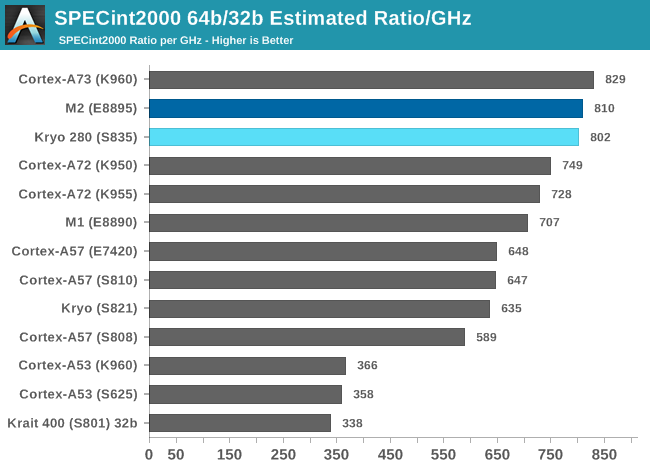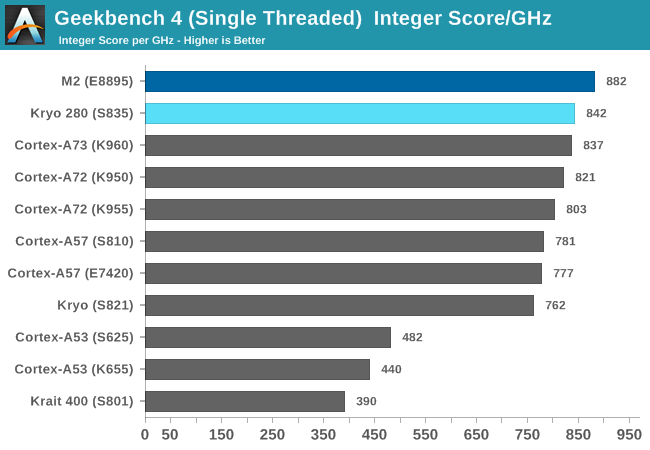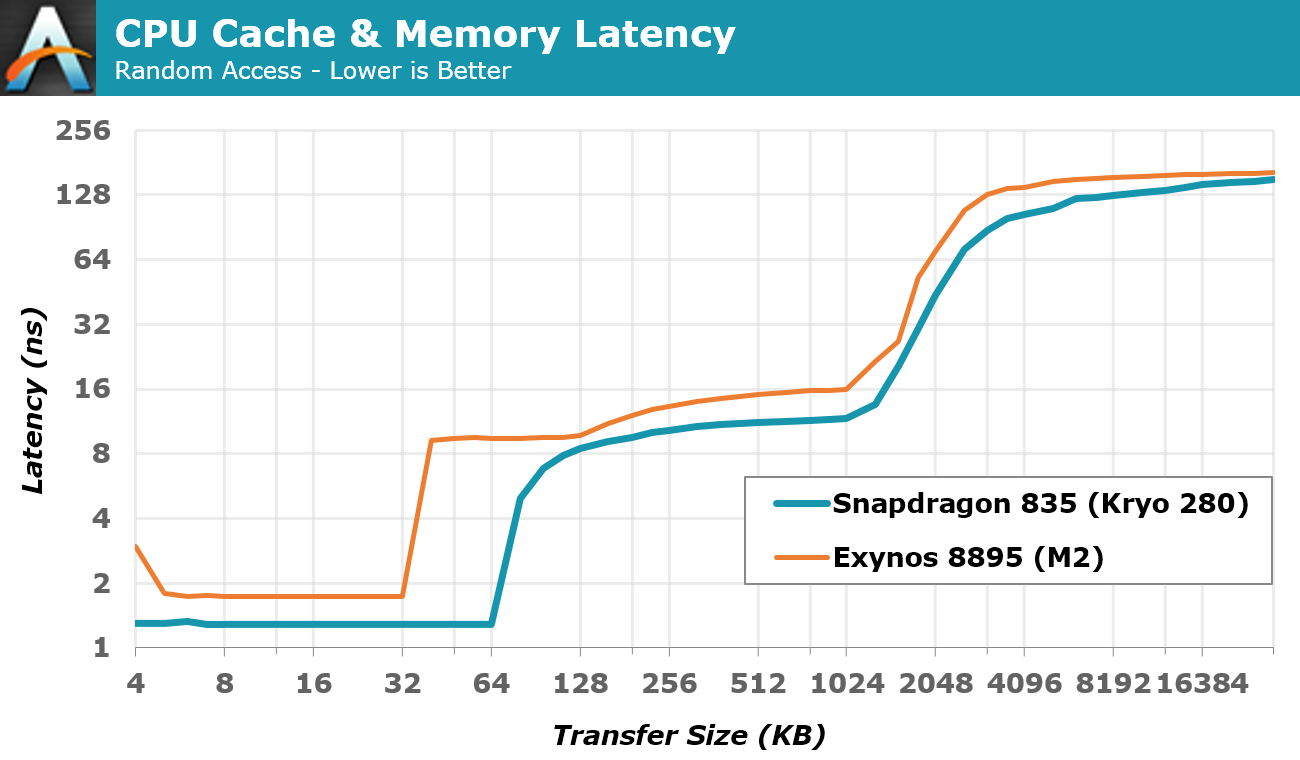Samsung Galaxy S8 Showdown: Exynos 8895 vs. Snapdragon 835, Performance & Battery Life Tested
by Matt Humrick on July 28, 2017 8:00 AM EST- Posted in
- Smartphones
- Samsung
- Galaxy
- Mobile
- SoCs
- Snapdragon 835
- Exynos 8895
- Galaxy S8
CPU Performance
Before we evaluate the Galaxy S8’s system-level performance and battery life, we’ll run some lower-level tests to examine CPU integer and floating-point IPC and memory system throughput and latency. The first test will be SPECint2000, the integer component of the SPEC CPU2000 benchmark developed by the Standard Performance Evaluation Corporation. This collection of single-threaded workloads allows us to compare IPC for competing CPU microarchitectures. The scores below are not officially validated numbers, which requires the test to be supervised by SPEC, but we’ve done our best to choose appropriate compiler flags and to get the tests to pass internal validation.
| SPECint2000 - Estimated Scores ARMv8 / AArch64 |
||||
| Exynos 8895 (Galaxy S8) |
Snapdragon 835 (Galaxy S8) |
Snapdragon 821 (LeEco Le Pro3) |
Kirin 960 (Mate 9) |
|
| 164.zip | 1120 | 1207 | 1273 | 1217 |
| 175.vpr | 3889 | 3889 | 1687 | 4118 |
| 176.gcc | 2000 | 1930 | 1746 | 2157 |
| 181.mcf | 1268 | 1146 | 1200 | 1118 |
| 186.crafty | 2083 | 2222 | 1613 | 2222 |
| 197.parser | 1125 | 1364 | 1059 | 1395 |
| 252.eon | 3333 | 3333 | 3714 | 3421 |
| 253.perlmk | 1698 | 1714 | 1513 | 1748 |
| 254.gap | - | 1864 | 1594 | 1930 |
| 255.vortex | 2235 | 1900 | 1712 | 2111 |
| 256.bzip2 | 1351 | 1376 | 1172 | 1402 |
| 300.twolf | 2113 | 2419 | 847 | 2479 |
The peak CPU operating frequencies for all the SoCs in the table above fall within 2% of each other, making it easier to compare IPC. It’s interesting to see how close the Exynos 8895’s M2 cores are to the Snapdragon 835’s Kryo 280 cores in integer performance. Each core separates itself in a couple tests—the S835 is faster in parser (21%) and twolf (14%) while the E8895 is faster in vortex (18%)—but generally the performance differences are less than 10%.
Both the M2 core inside E8895 and the Cortex-A73 core inside S835/K960 can dispatch 4 µops/cycle; however, there are some differences between their execution pipelines. The M1 (and from what I can tell the M2) has 2 simple ALU/INT pipes for basic operations, such as additions and shifts, and 1 complex pipe for muliplication/division. The A73 has 2 complex ALU/INT pipes. While both can handle basic operations, only one ALU handles integer multiplication and multiply-accumulate operations, while the other focuses on integer division. This means the M2 and A73 can both perform 2 basic operations in parallel but cannot perform 2 of the same complex operations in parallel. The A73 can dual issue a MUL/MAC alongside a divide/add/shift, which the M2 cannot do, but the M2 can issue 2 basic operations alongside 1 complex instead of a 1/1 split for A73. Obviously, any increase in throughput resulting from these differences will be highly workload dependent.

The chart above accounts for differences in CPU frequency by dividing the estimated SPECint2000 ratio score by CPU frequency, which makes it clear to see that, in this group of tests at least, there’s no IPC difference between Galaxy S8 models running Snapdragon 835 or Exynos 8895. We also see that there’s essentially no significant difference between Kirin 960’s A73 CPU core and Snapdragon 835’s semi-custom A73 core. Otherwise, the S835/E8895 hold a 26% IPC advantage over the previous generation Snapdragon 820/821, whose fully-custom Kryo CPU performs on par with the older ARM A57 core when running integer workloads.
While the in-order A53 CPU works very well as a lower-power companion core, building octa-core A53 SoCs does not make much sense. The bigger cores provide a significant performance advantage over the A53 – the older A57 is almost twice as fast here while the A73/M2 offer 2.2x more IPC – yielding a better overall user experience when dealing with the short, bursty workloads common to smartphone use cases. And for those of you still using a phone with a Snapdragon 801 SoC and wondering if buying a new flagship phone would deliver a noticeable performance gain, the answer is yes. The Krait 400 CPU in S801 performs about the same as the A53 in these integer workloads.
| Geekbench 4 - Integer Performance Single Threaded |
||||
| Exynos 8895 (Galaxy S8) |
Snapdragon 835 (Galaxy S8) |
Snapdragon 821 (LeEco Le Pro3) |
Kirin 960 (Mate 9) |
|
| AES | 971.2 MB/s | 905.4 MB/s | 535.8 MB/s | 911.6 MB/s |
| LZMA | 3.20 MB/s | 2.84 MB/s | 2.20 MB/s | 3.03 MB/s |
| JPEG | 17.2 Mpixels/s | 16.0 Mpixels/s | 21.7 Mpixels/s | 16.1 Mpixels/s |
| Canny | 29.1 Mpixels/s | 22.5 Mpixels/s | 31.2 Mpixels/s | 22.5 Mpixels/s |
| Lua | 1.63 MB/s | 1.70 MB/s | 1.43 MB/s | 1.72 MB/s |
| Dijkstra | 1.25 MTE/s | 1.58 MTE/s | 1.41 MTE/s | 1.53 MTE/s |
| SQLite | 42.2 Krows/s | 51.2 Krows/s | 36.5 Krows/s | 51.6 Krows/s |
| HTML5 Parse | 7.63 MB/s | 8.48 MB/s | 7.48 MB/s | 7.99 MB/s |
| HTML5 DOM | 2.50 Melems/s | 2.18 Melems/s | 0.84 Melems/s | 2.15 Melems/s |
| Histogram Equalization | 50.3 Mpixels/s | 49.9 Mpixels/s | 52.3 Mpixels/s | 48.6 Mpixels/s |
| PDF Rendering | 57.4 Mpixels/s | 47.2 Mpixels/s | 53.6 Mpixels/s | 44.6 Mpixels/s |
| LLVM | 231.8 functions/s | 250.1 functions/s | 164.8 functions/s | 260.4 functions/s |
| Camera | 6.58 images/s | 5.47 images/s | 7.17 images/s | 5.45 images/s |
The updated Geekbench 4 workloads give us a second look at integer IPC. Once again the performance difference between the S835 and E8895 is generally between 5% to 10%, although there is a bit more variation in these tests. The E8895 pulls ahead in Canny (29%), PDF Rendering (22%), and Camera (20%), while the S835 holds the advantage in Dijkstra (26%) and SQLite (21%).

After accounting for differences in CPU frequency, the E8895’s M2 core shows a minimal 5% advantage over S835’s Kryo 280 core in the Geekbench integer suite. As expected, the S835 and Kirin 960 perform the same, with both showing a negligible gain relative to the previous generation SoCs with A72 CPU cores. The integer IPC gap between the S835 and S820/S821 narrows to only 11% in Geekbench 4. The S820/S821 is still no better than SoCs with the A57 core despite posting better results in many of the individual integer tests. Its poor performance in LLVM and HTML5 DOM account for its lower overall score.
We tested the IPC of the A53 core using two different SoCs; in the Snapdragon 625 the A53 performs 10% better than its counterpart in the Kirin 655, primarily because of the Snapdragon’s lower memory latency (in-order cores are particularly sensitive to latency). Both A53 examples still manage to outperform the S801 however, with a margin ranging from 13% to 24%.
| Geekbench 4 - Floating Point Performance Single Threaded |
||||
| Exynos 8895 (Galaxy S8) |
Snapdragon 835 (Galaxy S8) |
Snapdragon 821 (LeEco Le Pro3) |
Kirin 960 (Mate 9) |
|
| SGEMM | 13.4 GFLOPS | 11.0 GFLOPS | 12.2 GFLOPS | 10.5 GFLOPS |
| SFFT | 4.02 GFLOPS | 2.76 GFLOPS | 3.26 GFLOPS | 2.88 GFLOPS |
| N-Body Physics | 924.5 Kpairs/s | 844.5 Kpairs/s | 1183.3 Kpairs/s | 832.6 Kpairs/s |
| Rigid Body Physics | 6234.9 FPS | 5941.6 FPS | 7169.6 FPS | 5879.2 FPS |
| Ray Tracing | 203.7 Kpixels/s | 220.6 Kpixels/s | 297.7 Kpixels/s | 221.8 Kpixels/s |
| HDR | 9.49 Mpixels/s | 8.13 Mpixels/s | 11.3 Mpixels/s | 8.10 Mpixels/s |
| Gaussian Blur | 27.2 Mpixels/s | 22.2 Mpixels/s | 48.0 Mpixels/s | 23.7 Mpixels/s |
| Speech Recognition | 15.3 Words/s | 13.2 Words/s | 11.5 Words/s | 12.8 Words/s |
| Face Detection | 583.4 Ksubs/s | 512.4 Ksubs/s | 681.4 Ksubs/s | 497.1 Ksubs/s |
While integer IPC is essentially the same between E8895’s M2 CPU and S835’s Kryo 280, the E8895’s floating-point IPC is notably higher, surpassing the S835 in every test except Ray Tracing. Its advantage over the S835 is particularly pronounced in the SFFT (46%), SGEMM (22%), and Gaussian Blur (23%) tests. The E8895 even manages to outperform the S820/S821 at times, which still has the best overall floating-point IPC of current SoCs, taking the lead in the SGEMM, SFFT, and Speech Recognition workloads.

After taking the geometric mean of the Geekbench 4 floating-point subtest scores and dividing by CPU frequency, the E8895 holds a 17% IPC advantage over the S835. The S820/S821’s IPC is still higher than both the E8895 and S835 by 11% and 31%, respectively. The S835’s Kryo 280 CPU delivers the same floating-point performance in these workloads as the A72 and A73, with all 3 CPUs showing a minimal 3-5% advantage over the older A57. Altogether, the past 3 generations of big CPU cores only show a 35% difference in floating-point IPC in Geekbench 4.
Memory Performance
The Geekbench memory tests show some performance differences between the Galaxy S8’s two SoCs. The E8895 performs significantly better than the S835 in the Memory Copy test that uses the memcpy() routine with randomized offsets; however, the S835 delivers higher bandwidth when streaming to system memory along with a 9% lower latency figure.
| Geekbench 4 - Memory Performance Single Threaded |
||||
| Exynos 8895 (Galaxy S8) |
Snapdragon 835 (Galaxy S8) |
Snapdragon 821 (LeEco Le Pro3) |
Kirin 960 (Mate 9) |
|
| Memory Copy | 6.74 GB/s | 4.32 GB/s | 8.05 GB/s | 4.60 GB/s |
| Memory Latency | 147.5 ns | 134.4 ns | 150.2 ns | 140.4 ns |
| Memory Bandwidth | 14.95 GB/s | 16.87 GB/s | 13.93 GB/s | 17.23 GB/s |
It’s always interesting to look further back in time to see how performance has improved over several generations. In this case, the memory bandwidth test shows the biggest gains when comparing the Galaxy S8 to the Galaxy S5 (S801) and Galaxy S6 (E7420), where the older SoCs can only muster 6.95GB/s and 7.51GB/s, respectively, compared to at least 14.95GB/s for the S8 (E8895). The gains in the Memory Copy test are not as dramatic, with the Snapdragon version of the S8 (4.32GB/s) showing a small improvement over the S5 (3.98GB/s) and S6 (3.35GB/s). The transition from LPDDR3 to higher-frequency LPDDR4 DRAM along the way certainly helped boost performance, as did improvements in CPU microarchitecture (the AGUs in particular).
The S835’s Kryo 280 CPU comes with twice the L1 cache as the E8895’s M2 CPU, 64KB versus 32KB, respectively. The Kryo 280’s L1 latency remains steady at 1.28ns, the same as the A73 core in the Kirin 960, which is about 26% better than the M2’s 1.74ns latency figure. The S835 extends this same latency advantage to the L2 cache as well. The S835’s latency advantage over the E8895 shrinks to 9%, nearly matching the Geekbench 4 result, when accessing main memory at the upper limit of our own internal test.
Overall, the E8895’s M2 CPU core holds a small IPC advantage over the S835’s Kryo 280 core in floating-point workloads, but the two cores are pretty evenly matched when working with integers. There are a few specific workloads where each microarchitecture shines, but the theoretical performance difference between the Galaxy S8’s two SoC choices is not as large as expected.











137 Comments
View All Comments
philehidiot - Friday, July 28, 2017 - link
A subjective comparison of the two would be good if you can manage it although I appreciate Anandtech is struggling for smartphone reviewers and getting the two models for long enough could be an issue. From my POV my S8 E8895 is pretty slick but you notice the bloatware and it really isn't as smooth as it ought to be. I feel a lot of it is down to poor optimisation of the bloatware which is forced upon you. What I do rather like is the dialer (whilst slow) does look up the number and alert you to "suspected spam" so you can choose to answer the phone as the Savoy Grill or, my personal favourite, the interrogation chamber at Guantanamo Bay.Disabling Bixby on this thing is a must as it's just annoying, intrusive and slows everything down. As well as being useless. I took a picture of a chocolate bar, used "Bixby Vision" to try and search for similar things (dunno why you'd want to do this) and it showed me a bag of chocolate dicks. Erm... okay.... thanks, Samsung.
coder111 - Friday, July 28, 2017 - link
What about AOSP or LineageOS support? I know most people don't care, but I do. Is it more likely that Exynos S8 will get decent support, or Snapdragon one? Because that's the major selling point for me. Until there's LineageOS for Samsung S8, I'll prefer OnePlus5.Notmyusualid - Sunday, July 30, 2017 - link
No LineageOS just yet, I've just checked. Loaded Batman ROM instead, seems OK. I changed the ROM, as the phone kept updating, re-enabling bloatware, and making the 'buttons' default to disappear each time, for each app. Also, to my annoyance, I could not uninstall Facebook.But the biggest thing I've not seen mentioned is the fact that the E8895 is a dual-sim phone, which the Snapdragon is not.
My S8 Plus, I noted, was 3rd fastest on the planet in Antutu benchmarks, and cost 31,050 THB, from the Samsung store. Now that the ROM is changed, I'm happy.
jrapoport - Friday, July 28, 2017 - link
so, you say "lets see how hardware and software work together"... yet you don't try the "samsung app" on a "samsung phone"... I wonder how the chrome-based benchmarks would come out on the samsung browser instead of using chrome?I know that would make it harder to actually compare apples-to-apples (ha!), but since benchmarks are really already borderline useless, might at least try to make a fairer useless comparison, right?
safari on iPhone, vs chrome on pixel vs samsung browser on samsung phone... I'm guessing they might have some further optimizations going on there?
Infy2 - Friday, July 28, 2017 - link
AT apparently no longer provides full featured phone reviews. At this time of the year we have previously seen reviews of Samsung, LG and HTC flagships.jospoortvliet - Friday, July 28, 2017 - link
I prefer these unique in-dept dives in hardware over generic reviews you can find on any other site... Great read, as always, though I'd love to see even more about he power usage.Also, when the SOC's are so closely matched by low level benches but the PCMark test shows such a huge difference (note only that one, not the browser benchmarks or games) it might be worthwhile to consider the PCMark test might not be entirely objective. Any other way to manually test some of its scenario's like writing etc to verify it isn't (accidentally, I'm sure) slanted towards the Snapdragon?
Of course it is a reality that there's probably more software optimized for the ubiquitous snapdragon than for the SAMSUNG SOC but with a difference THIS big I think it is warranted to look a bit deeper, ask the vendor perhaps if they have a clue at what might be wrong etcetera.
Lau_Tech - Friday, July 28, 2017 - link
Let's see if this new approach endures with the new iphoneBadelhas - Friday, July 28, 2017 - link
The only thing missing is the HTC U11 to that comparisonBrokenCrayons - Friday, July 28, 2017 - link
6.2 inches of screen! That's huge. My first Android tablet had a 7 inch screen. Yeah, there's a lot less bezel around it, but there's a point where a phone becomes too impractical to carry and use and I feel in the name of specs and selling points, we've long since passed that with flagship devices. I'd love to see flagship specs in maybe a 4 to 4.5 inch device. I have nowhere to carry something that big. I guess if it was my only computing device maybe there'd be an excuse for it, but wireless docking and charging would be a must and I'd still prefer a mix of a laptop for big computing tasks and a small phone for computing/communications while on the road.goatfajitas - Friday, July 28, 2017 - link
I hear you, but it isnt that big. It's very close to the iPhone 6+ and 7+ in size even though they have a 5.5 inch screen... That and the 5.8 inch model is even smaller, closer to 5.2 inch models from the past 3-4 years. Anyhow, there are options, but what suits you.